
Control Modules
Turn controller power off before servicing controls. This
ensures safety and prevents damage to controller.
The Processor module (PSIO), 8-input (Options) mod-
ules, Starter Management Module (SMM), and the Local
Interface Device (LID) module perform continuous di-
agnostic evaluations of the hardware to determine its con-
dition. See Fig. 39-43. Proper operation of all modules is
indicated by LEDs (light-emitting diodes) located on the
side of the LID, and on the top horizontal surface of the
PSIO, SMM, and 8-input modules.
RED LED — If the LED is blinking continuously at a
2-second rate, it is indicating proper operation. If it is lit
continuously it indicates a problem requiring replacement
of the module. Off continuously indicates that the power
should be checked. If the red LED blinks 3 times per sec-
ond, a software error has been discovered and the module
must be replaced. If there is no input power, check fuses and
the circuit breaker. If fuse is good, check for shorted sec-
ondary of transformer, or if power is present to the module,
replace the module.
GREEN LEDs — There are one or 2 green LEDs on each
type of module. These LEDs indicate communication status
between different parts of the controller and the network mod-
ules as follows:
LID Module
Upper LED — Communication with CCN network, if present;
blinks when communication occurs.
Lower LED — Communication with PSIO module; must
blink every 5 to 8 seconds when the LID default screen is
displayed.
PSIO Module
Green LED Closest to Communications Connection —Com-
munication with SMM and 8-input module; must blink
continuously.
Other Green LED — Communication with LID; must blink
every 3 to 5 seconds.
8-Input Modules and SMM
Green LED — Communication with PSIO module; will blink
continuously.
Notes on Module Operation
1. The chiller operator monitors and modifies configura-
tions in the microprocessor through the 4 softkeys and
the LID. Communication with the LID and the PSIO is
accomplished through the CCN bus. The communication
between the PSIO, SMM, and both 8-input modules is
accomplished through the sensor bus, which is a 3-wire
cable.
On sensor bus terminal strips, Terminal 1 of PSIO mod-
ule is connected to Terminal 1 of each of the other
modules. Terminals 2 and 3 are connected in the same
manner. See Fig. 39-43. If a Terminal 2 wire is connected
to Terminal 1, the system does not work.
2. If a green LED is solid on, check communication wiring.
If a green LED is off, check the red LED operation. If the
red LED is normal, check the module address switches
(Fig. 39-43). Proper addresses are:
MODULE
ADDRESS
S1 S2
SMM (Starter Management Module) 32
8-input Options Module 1 64
8-input Options Module 2 72
If all modules indicate communications failure, check com-
munications plug on the PSIO module for proper seating.
Also check the wiring (CCN bus — 1:red, 2:wht, 3:blk;
Sensor bus — 1:red, 2:blk, 3:clr/wht). If a good connec-
tion is assured and the condition persists, replace the PSIO
module.
If only one 8-input module or SMM indicates commu-
nication failure, check the communications plug on that
module. If a good connection is assured and the condi-
tion persists, replace the module.
All system operating intelligence rests in the PSIO mod-
ule. Some safety shutdown logic resides in the SMM in
case communications are lost between the 2 modules. The
PSIO monitors conditions using input ports on the PSIO,
the SMM, and the 8-input modules. Outputs are con-
trolled by the PSIO and SMM as well.
3. Power is supplied to modules within the control panel via
21-vac power sources.
The transformers are located within the power panel, with
the exception of the SMM, which operates from a
24-vac power source and has its own 24-vac transformer
located within the starter.
Within the power panel, T1 supplies power to the LID,
the PSIO, and the 5-vac power supply for the transduc-
ers. The other 21-vac transformer is T4, which supplies
power to both 8-input modules (if present). T4 is capable
of supplying power to two modules; if additional mod-
ules are added, another power supply will be required.
Power is connected to Terminals 1 and 2 of the power
input connection on each module.
Fig. 39 — PSIO Module Address Selector Switch
Locations and LED Locations
78


















